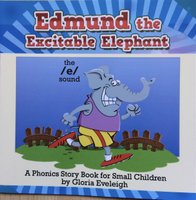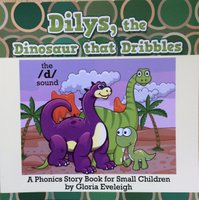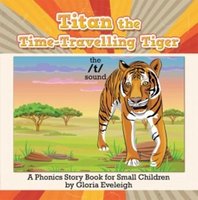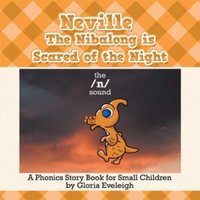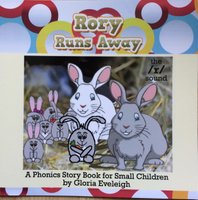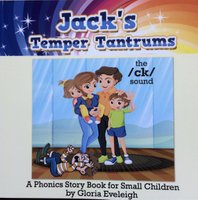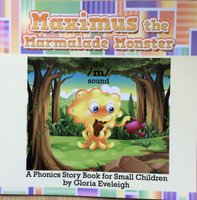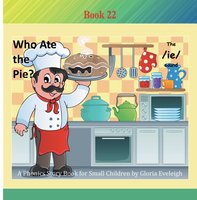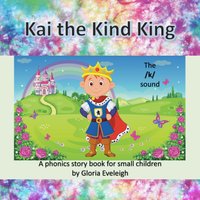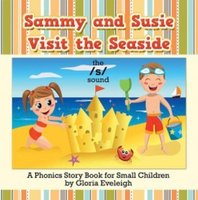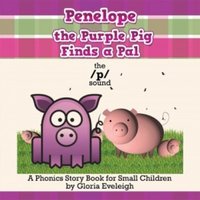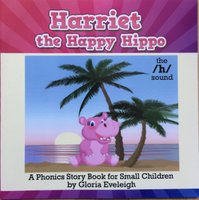Welcome to my Website.
I am Gloria Eveleigh, Champion for abuse survivors and multi-award winning Author.
1
4
5
8
9
13
2
3
6
10
7
11
AWARDS AND REVIEWS
THIS PAGE COVERS THE BIRTH, DEVELOPMENT, REVIEWS, & AWARDS OF MY PHONICS PICTURE STORYBOOK SERIES FOR SMALL CHILDREN
May 2023: My phonics books were born in 2015. They began as illustrated storybooks for my sister to use at her Phonics-For-Fun group where she taught 2-4 year-olds individual phonics sounds one at a time through different activities. The letter/s making up the sound were highlighted so that the children could recognise the shape of the letter/s and repeat the sound that they made. This made the books unique. As a result of popular demand from the parents, I first produced the books myself and then commissioned an Indie publisher to produce them. The idea snowballed so that my goal became to write and publish a book for each of the 42 phonics sounds that are needed to enable a child to read fluently. The problem was that the Indie publisher set the retail cost of each book far to high to attract parents to buy and collect the whole series. But they had the publishing rights even though I still owned the copywrite. So I ended the contract, recovered all of the book galleys, and began to republish the books myself on Amazon Kindle Direct Publishing for an easily affordable price of £4 each. To date, the following books have been republished:
All twelve of the above books are in the order the sounds must be learnt. After learning 6 sounds; the child should be able to read simple sentences. Reading then improves with each new sound learned.
I have also published the following book prematurely. It is part of the series but is number 22. I published it because an Indie publisher told me he was in exclusive partnership with Amazon so I would have to publish it through him. I proved him wrong.
The following book is one I published recently just for fun. Originally I wrote it for my grandson, Kai, when he was a little boy. He's a grown up seventeen year old old now. It isn't one of the 42 sounds I talked about above, but none-the-less, is an additional sound that is useful for a child to learn.
I will be re-publishing the rest of this series of phonics book gradually over the next several months.
Below, you will find the reviews I have received for various of my phonics books since 2015. If you would like to write a review, please email it to me on gloriaeveleigh@icloud.com
MAINCREST MEDIA REVIEW OF, and AWARD
fo KAI THE KIND KING
Kai the Kind King by Gloria Eveleigh is a colorful children’s picture book designed to help young readers learn and practice the letter “K.” Written in a simple, easy to read manner, the book makes for a great read aloud for children ages 2-6. The bright, colorful illustrations will captivate a little one’s attention and provide good teaching opportunities for educators and parents to explain unique ”K” words including the character’s names and important symbols and objects in the story. Young ones will delight in Kai the Kind King, as it brings the fun back into learning. This book has been selected for a Maincrest Media Book Award in the Children’s Picture Book category. (14th September 2022)
MID WEST BOOK REVIEW OF 'NEVILLE THE NIBALONG IS SCARED OF THE NIGHT'
Neville the Nibalong is Scared of the Night
The /n/ sound Gloria Eveleigh, author/illustrator
http://www.gloriaeveleighphonicsstorybooksforsmallchildren.com
Sixth in a creative phonics series for young children, "Neville the Nibalong is Scared of the Night" is a fantasy phonics story to teach children the sound of the letter /n/. Curiously illustrated with small orange mini-dragon-like creatures called Nibalongs, the story unfolds in prose poetry, with the letter "n" emboldened throughout to encourage familiarity. Neville plays with his friend Nathan in the dark, but he is "niggled" because he is scared of the dark. So one day Neville and Nathan decide to wake up in the daylight and see each other for the first time! They are horrified at the sight of each other's noses. Against a backdrop of real daylight photo-forest scenes, Neville and Nathan meet a newt named Norman, who leaves because he doesn't like their nasty, nobbly noses. Next they meet a nightingale named Nancy who also flies off because she doesn't like their noses. Next they meet a dog named Nigel who barks and chases them. finally the two Nibalongs decide that they have been naive about preferring the day to the night. They are yawning and tired and relieved when darkness comes. determined to stay awake all night, they nevertheless are asleep when the sun rises, having learned two things: "Firstly, they never again want to wake up in the light. Secondly, they will never again be scared of the night!" "Neville the Nibalong is Scared of the Night" is a delightful, enticing story that effortlessly teaches young readers all about the sound of "n," while also inviting a fun, playful learning phonics experience.
US BOOK REVIEW OF 'SAMMY AND SUSIE VISIT THE SEASIDE' by Jordana Landsman
"But more than anything, Sammy and Sue want to learn to swim in the sea." Kids love repetition. They relish the same stories and refrains over and over (and over) again. If the material rhymes or alliterates, they don’t just love it, they sing it. Repetition helps kids learn, reinforce, control, anticipate. Parents might think one more rendition of a favorite stanza will send them over the edge of sanity, but kids just say, “Read it again!” This diminutive book effectively taps into kid rhythm with its lilting, letter-“S”-centric story about a brother and sister who visit relatives at the beach and dream of learning to swim. Ending each page is the soon-familiar refrain, “Sammy and Susie want to learn to swim in the sea.” Any conversational child worth her weight in giggles will join in the recitation before the book ends and may even continue chanting the refrain long after reading time ends. Children may not even notice how the book stuffs its sea-faring self with a solid stockpile of “S” words. There is a lot for parents and kids to enjoy here. The supersized “S” supply solidly supports pre-literacy awareness of letters, which is valuable to young children who are learning the alphabet and beginning to recognize the configuration of words on the page. The story also, on a simple, kid-appropriate level, creates a conflict that must be resolved. These kids want to swim! The seashore is great, there’s a lot to do, but they have a goal. They need a grownup’s help. They are motivated, adventurous, and excited to learn this new skill and engage more deeply with the joys of the beach. Small, memorable, sneakily educational books like this are often winners with little kids, so often adults cram books full of words and complex ideas, wanting to tell everything to captive little ears. But captive little ears don’t need intense narratives; they need a simple concept with short, happy, memorable bursts of language that they can access, understand, and enjoy. The smallest, most basic books can galvanize a young imagination. Give a kid the spark, and his mind will run with it. Illustrations are an important part of this equation. Sammy and Susie’s happy-faced, cartoonish images are simple but engaging, casting family beach days as whimsical and bright. Kids like looking at other children’s faces, and as Sammy and Susie smile out from among their beach toys, young readers perceive the characters’ enthusiasm. For children who may not yet have visited a beach or have been frightened by early visits, the visible pleasure Sammy and Susie take in their seaside escapades may have a positive effect on their feelings about the beach. Other positives may rub off on young readers as well. Learning to swim is a rite of passage in childhood, and it often launches with fear and skepticism from the child. But as young readers see Sammy and Susie’s happy faces and absorb the urgency with which this duo wants swim lessons, even the most water-resistant little landlubber might open her mind to the possibility that learning to swim could be a desirable and fun activity to undertake. Sammy and Susie want to learn to swim in the sea; maybe I can learn too!
REVIEW OF ‘SAMMY AND SUSIE VISIT THE SEASIDE’ by Hilary, Nursery Assistant Brightsaurus Nursery Hove UK
What I like about this storybook: - The pictures were detailed and interesting to look at. The children really enjoyed picking different objects out and naming what they are. The ‘s’ words were in bold so if a child was reading the story one on one looking at the book it would help with the words standing out. How I think this storybook could be improved: - The storybook was really good. It is a great way to learn. Maybe the storybook could be improved by involving rhyme into some pages as I know children at this nursery seem to enjoy rhyming books
How the children reacted to this storybook: - The children really enjoyed the storybook. They enjoyed joining in with actions and picking different objects out on each page.
REVIEW OF SAMMY AND SUSIE VISIT THE SEASIDE BY Paige, Nursery Assistant Littlesaurus Nursery Shoreham-by-Sea UK
I liked how simple but engaging the story was. The story was repetitive at times and also very easy to remember and understand. I liked how it was clearly outlining the key events of the story and also it outlined the /s/ sound well. The story was good because children were linking their own experiences with the book. I think that rhyming couplets could be added into the book. An activity could possibly be added into the back. For example, can children find all of the objects starting with the /s/ sound. Children were sharing their own ideas and experiences. Children were listening well and then asking questions and getting involved with identifying the pictures.
REVIEW OF SAMMY AND SUSIE VISIT THE SEASIDE BY Adrianne, Nursery Assistant Supersaurus Nursery Hove UK
The story is very good. I like that the children get involved with the /s/ sound. The children could be more engaged by you maybe adding props like a bucket and spade and maybe some shells when you read it. All the children really enjoyed the storybook. They all really interacted with you while you were reading it, and were all really interested.
COMMENTS ABOUT THE STORYBOOKS IN GENERAL FROM THE PARENTS WHO ATTENDED, ‘PHONICS FOR FUN’ WITH THEIR CHILDREN July 2015:
“My daughter … enjoys looking at the books at home, as we have bought one each week.”
“The stories are an excellent way to re-iterate the sound and fully puts into context how the sound/ letter is used in a sentence.”
REVIEW OF JACK'S TEMPER TANTRUMS FROM TORONTO WORD ON THE STREET BOOK FAIR 2016
"JACK’S TEMPER TANTRUMS A Phonics Story Book for Small Children GLORIA EVELEIGH "Jack is a happy little boy with a lovely family that gives Jack lots of attention. Jack’s brother, sister, Mummy and Daddy play with Jack and teach him things. There is just one problem. Jack has temper tantrums. This makes life difficult for everyone. Can Jack change? This is one of a set of 12 phonics storybooks – A brilliant teaching aid for parents and teachers."
REVIEW OF DILYS THE DINOSAUR FROM TORONTO WORD ON THE STREET BOOK FAIR
Dilys, the dinosaur, is born without teeth so dribbles a lot. Other young dinosaurs will not play with her, so Dilys feels sad and lonely. Will her mummy and daddy dinosaurs solve Dily’s problem so she can become a happy little dinosaur again? This is one of a set of 12 phonics story books. A brilliant teaching aid for parents and teachers.


